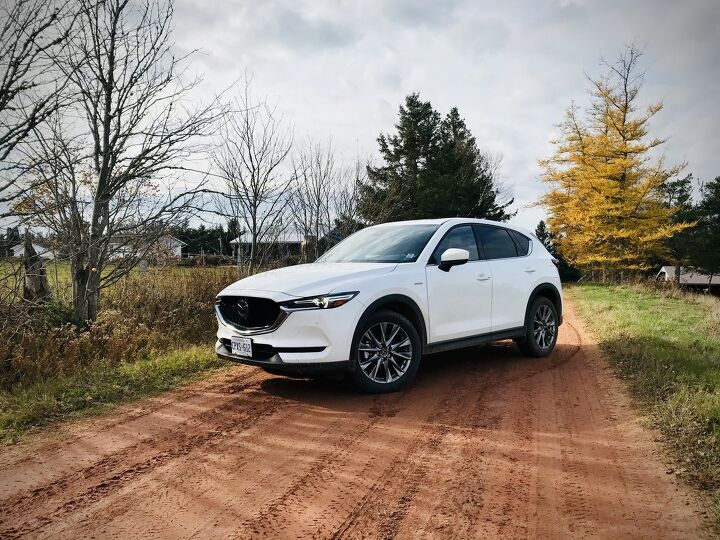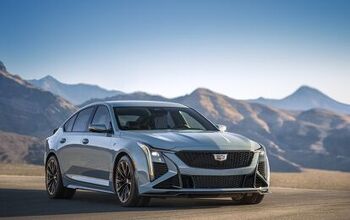After Driving Two Turbocharged Mazdas for Two Weeks, Mazdaspeed is Actually Kind of Alive
We all asked Mazda for more power. It was a cry rising up from virtually every corner of the automotive industry – enthusiasts, observers, analysts, insiders, owners, fans – largely due to the fact that Mazda marketed an entire lineup of vehicles as machines for keen drivers, and none of those machines offered meaningful horsepower.
The Mazda 6 dropped its V6 engine after the 2013 model year, which led to horsepower maxing out at 184 in the following iteration. The Mazdaspeed 3 and its sub-14-second quarter-mile likewise called it quits in 2013. In 2014, the Mazda 2 was still fighting with a measly 100 horsepower. While Ford sold Escapes with 245 horsepower (and 275 lb-ft of torque), the 187-horsepower Mazda CX-5’s naturally aspirated 2.5-liter was merely enough. In fact, up until 2018, the only Mazda with more than 200 horsepower was the roughly 4,400-pound Mazda CX-9.
By way of the CX-9’s 2.5-liter turbo, 2018 brought more than 300 lb-ft of torque to the Mazda 6. The same engine appeared in the CX-5 for 2019 (when Mazda amped up the MX-5 to the tune of a sub-6-second 0-60 time), and is now finding its way under the hood of the Mazda 3 and Mazda CX-30.
Two-hundred and fifty horsepower at 5,000 rpm. Three-hundred and twenty lb-ft of torque at 2,500 rpm. Six distinct body styles. Base prices (including freight) ranging from $31,000 to $35,060. Doesn’t it kind of sound as though the officially defunct Mazdaspeed performance sub-brand is actually, what’s the word we’re looking for here … alive?
News that Mazdaspeed is dead isn’t news. There hasn’t been a Mazdaspeed car in more than seven years. We reported on the likelihood (by which mean the decreasing likelihood) of Mazdaspeed’s return in early 2017, more than three years before the latest batch of cold water was thrown on the dimming embers. Mazdaspeed wasn’t in the offing in early 2017, but the frequency of turbo installations was. Speaking of the CX-5, “If it’s up to me, we’ll put the 2.5 turbo in there, too,” Mazda engineer Dave Coleman said.
The 2.5 turbo is indeed on the CX-5 options list now. I spent a week in early November in a Canadian-spec 100th Anniversary edition priced at an eye-watering CAD $45,620, but Americans can select an all-wheel-drive, turbocharged 2021 CX-5 at $33,160, $36,385, or $38,505.
To be honest, it’s hardly a traditional performance powerplant: Mildly unrefined at low rpm, not terribly excited about revving, generally behaving like it was born to petrol parents but adopted by a family of diesels. The mid-range torque in the 2.5 turbo, however, transforms the character of the CX-5. Three-hundred and twenty lb-ft of twist stirs up the desire to overtake anything that moves. The turbo shaves the CX-5’s 50-70 mph acceleration time from 5.5 to 4.3 seconds, according to Car And Driver.
The CX-5 is an ideal foundation for a performance crossover, the likes of which don’t really exist. There’s no ST-badged Escape, no CR-V Si or Forester XT or Equinox SS. The CX-5’s steering is properly weighted. The suspension is tuned for decent ride quality along with cornering speeds that would cause many competitors to blanch. Brake feel is nicely balanced. The CX-5’s Sport mode even shifts enough algorithms to steer the CX-5’s powertrain toward real responsiveness.
Of course, the CX-5 doesn’t have the boy-racer bodywork to merit a Mazdaspeed badge. Moreover, the exhaust note isn’t rorty. The 225/50R19 tires aren’t of a sufficiently low profile. And the ride quality isn’t jarringly awful.
In fact, whether you’re in a turbocharged CX-5 or a blacked-out CX-9 or any of the other newly turbocharged Mazdas, the cosmetics won’t support the notion of extra power. A turbocharged Mazda’s driving experience in each case is likely to present layers of evidence on behalf of its client, Mr. Athleticism, but unlikely to ever disclose any rendezvous with the ex, Mrs. Unruly Torque Steer.
Mazda’s capacity for taming the 199.4-inch CX-9 shows the company is more than capable of crafting a performance car. Canada’s CX-9 Kuro, akin to the Carbon Edition south of the border, is remarkably measured. Tens of thousands of CX-9 drivers will never push the hefty brute hard enough to be wowed by its composure. Clearly, these Mazda engineers are people who spend years in pursuit of MX-5 handling perfection. And the influence of that vehicle – just influence, mind you, not punching in 200 percent on a Xerox – is obvious in this 4,396-pounder. On twisty, rural, Island roads, the CX-9 falls into a groove as speeds increase, the exact opposite of what happens to the overwhelming majority of high-riding family crossovers.
Yes, Mazda can do Mazdaspeed. They can. But they won’t. The prices required to support it simply won’t result in sufficient marketplace uptake. Yet the broad availability of horsepower now gives Mazda a leg to stand on in terms of communicating the brand’s performance credentials. Mazda’s new aim is to add to those performance credentials a waft of premium.
Horsepower’s the easy part – there’s still no replacement for displacement. Crafting an upmarket image, on the other hand, isn’t quite so straightforward.
Timothy Cain is a contributing analyst at The Truth About Cars and Driving.ca and the founder and former editor of GoodCarBadCar.net. Follow on Twitter @timcaincars and Instagram.
More by Timothy Cain
Latest Car Reviews
Read moreLatest Product Reviews
Read moreRecent Comments
- El scotto @jalop His maintenance costs are about right. Sorry about your alternative reality.
- Kwik_Shift_Pro4X Just because you don't see many of them on the road doesn't mean they go up in value. I'm sure finding parts for it will be an adventure. 🙄
- FlyerTuck My middle-aged parents (father) at the time ordered a new 1996 DeVille Concours Edition. The engine was butter smooth and could move that land yacht well. It rode well too on the highway and floated, but it couldn't handle out of its own way. My mother loved it, but my performance oriented father grew to hate it over time. He wanted something he could still whip around back roads like the sports cars he used to own before marriage. He traded it on a BMW 7-series after not even two years, and while my mother said it wasn't as comfortable and took bumps more harshly, could live with it. Something about rear wheel drive and independent suspension magic. GM just never learned.
- FlyerTuck What is amazing when you think about it is that Honda started out just a motorcycle maker during the post-WWII Reconstruction period. They've come a long way very quickly, and took out American competition that had been around twice as long.
- El scotto Stupid is as stupid does. I would imagine most car dealers only computerized when some salesperson showed them it could make/save them money. Pay for anti-virus protection and such? A waste of dealership money. BTW does anyone know if Bark Baruth has written anything on this?





































Comments
Join the conversation
Weak sauce (or is it near-beer) comes from most of the Japanese majors. TRD ? Suspension is where it ought to be, engines nope. Acura A - Spec ? One nice styling job and expensive wheels. No engine. Honda ? If you force us we'll do an Si and a dozen Mugen, not that you'll ever find one without a 10k dealer markup. At least the Germans and Americans will often sell you a version with actual performance, but the Japanese majors, who ably demonstrate performance in the euro market, leave it alone here for mass market, Consumer Reports friendly, doesn't annoy the insurance people, dull motors.
The problem is that Mazda decided to bail on quality for Gen 4 Mazda 3s. That POS rear suspension is a serious issue, and the fact that you can't combine a manual with the turbo is criminal. Why can't I combine a manual with AWD and the turbo? OTOH it likely increases the future value of my 2017 GT. But still a little disappointed with the Mazda 3 offerings for Gen 4.